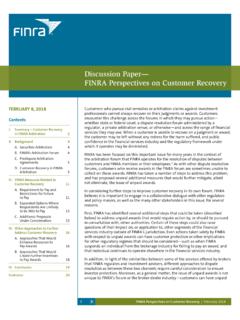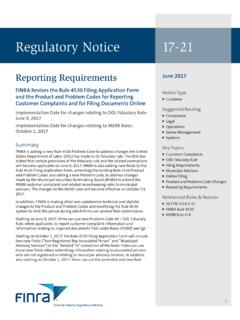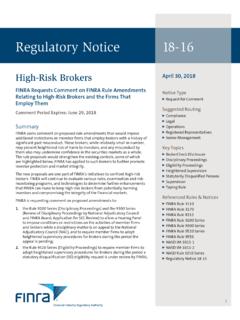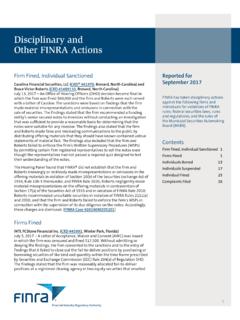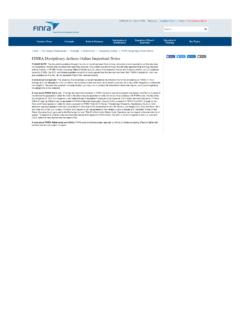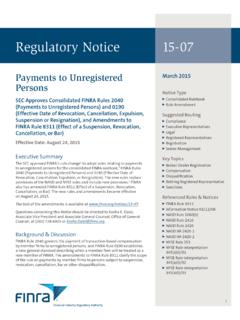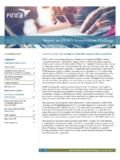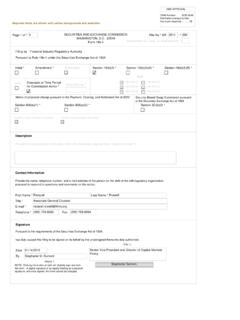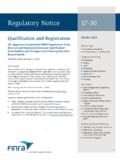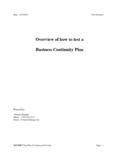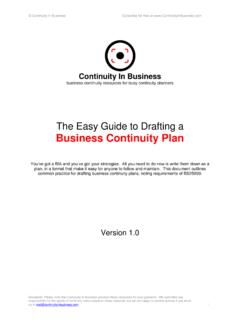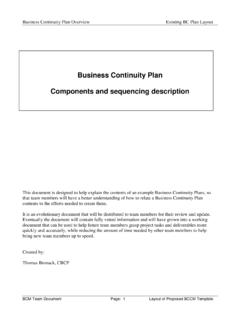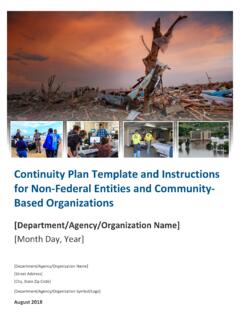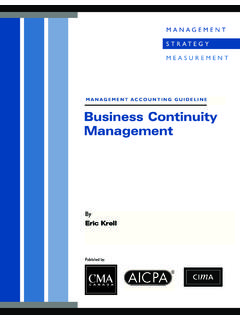Transcription of Business Continuity Plan Template for Small Introducing ...
1 Business Continuity plan Template for Small Introducing Firms [Firm Name]. Business Continuity plan (BCP). Updated May 12, 2010. This optional Template is provided to assist Small Introducing firms in fulfilling their need to create and maintain Business Continuity plans (BCPs) and emergency contact person lists under FINRA Rule 4370 ( Business Continuity Plans and Emergency Contact Information). The Template recognizes that many Small Introducing firms rely on parts of a clearing firm's or other entity's BCP for many of the mission-critical functions of the Introducing firm. Nothing in this Template creates any new requirements on clearing firms or other entities, or new requirements for BCPs. Note: Following this Template does not guarantee compliance with or create any safe harbor with respect to FINRA rules, the federal securities laws or state laws.
2 The obligation to develop a BCP is not a one-size-fits-all requirement, and you must tailor your plan to fit your particular firm's situation. FINRA Rule 4370(c) requires that firms relying on another entity for elements of their BCP or mission-critical systems must address that relationship in their plan . This Template is written for Small Introducing firms that use a clearing firm, and includes sample language regarding the nature of that particular relationship only. If your firm conducts a different type of Business ( , sells only mutual funds), you must modify the Template to describe the entities you rely on and the nature of those relationships. The language contained in this Template is provided as a starting point for developing your firm's plan .
3 It is highly unlikely that the language of this Template standing alone will fully fit your firm's Business situation. In this regard, you must customize the language of this Template to reflect your firm's activities and issues. If you have prepared a plan in a different format, you may wish to attach the appropriate sections of that plan to this Template to confirm that you have addressed all of the individual elements. 1. Critical Elements There are 10 critical elements of a BCP specified in FINRA Rule 4370. Each firm need only address the elements applicable to its Business , but if you do not include a specified element in your firm's plan , your plan must document why it is not included: (1) Data back-up and recovery (hard copy and electronic);. (2) All mission critical systems.
4 (3) Financial and operational assessments;. (4) Alternate communications between customers and the member;. (5) Alternate communications between the member and its employees;. (6) Alternate physical location of employees;. (7) Critical Business constituent, bank, and counter-party impact;. (8) Regulatory reporting;. (9) Communications with regulators; and (10) How the firm will assure customers' prompt access to their funds and securities in the event that the member determines that it is unable to continue its Business . Keep in mind that the above-listed elements are not exhaustive; you should address other key areas for your plan to be complete and thorough, based on your firm's Business and operations. TEXT EXAMPLES are provided to give you sample language that you can modify to create your firm's plan .
5 Material in italics provides instructions, citations to relevant rules and other resources that you can use to develop your firm's plan . The FINRA BCP Web page includes important information and links to other websites with useful information. You may also consider consulting the General Accounting Office's reports on Potential Terrorist Attacks: Additional Actions Needed to Better Prepare Critical Financial Market Participants, Report Nos. GAO-03-251(Feb. 2003). and GAO-03-414 (Feb. 2003); the Draft Interagency White Paper on Sound Practices to Strengthen the Resilience of the U. S. Financial System by the Securities and Exchange Commission (SEC) and other federal financial institution regulators; and the Business Continuity information on the websites of the Securities Industry and Financial Markets Association (SIFMA), the Business Continuity Institute (BCI) and the Financial Services Sector Coordinating Council for Critical Infrastructure Protection and Homeland Security (FSSCC).
6 Firms relying on third-party providers to provide services in connection with their BCPs should review Notice to Members (NTM) 05-48, (July 2005). For historical guidance and background, see NTM 04-37 and Regulatory Notices 07-42 and 09-60. 2. I. Emergency Contact Persons Identify your firm's two emergency contact persons. Your firm must identify its emergency contact persons through the FINRA Contact System (FCS). In addition, your firm must use FCS to update the contact information promptly (but no later than 30 days following any change in the information) and annually review and update, if necessary, the information within 17 Business days after the end of each calendar year. Each emergency contact person must be an associated person of the firm, and at least one emergency contact person must be a member of senior management and a registered principal of the firm.
7 If your firm designates a second emergency contact person who is not a registered principal of your firm, then that contact person must be a member of senior management who has knowledge of the firm's Business operations. If your firm has only one associated person, the second emergency contact must be an individual, either registered with another firm or non-registered, who has knowledge of your firm's Business operations ( , your firm's attorney, accountant or clearing firm contact person). TEXT EXAMPLE: Our firm's two emergency contact persons are: [name, phone number, email] and [name, phone number, email - identify second person's relationship to the firm if not a registered principal of the firm]. The firm will provide FINRA with the contact information for the two emergency contact persons: (1) name; (2) title; (3) mailing address; (4) email address; (5) telephone number.
8 And (6) facsimile number through the FINRA Contact System (FCS). [Name] will promptly notify FINRA of any change in this information through FCS (but no later than 30 days following the change) and will review, and if necessary update, this information within 17 Business days after the end of each calendar year. Rule: FINRA Rule 4370(f); NASD Rule 1160. II. Firm Policy State your firm's objectives for Business Continuity in the face of both internal and external significant Business disruptions (SBDs), including your firm's obligation to grant customers access to their funds and securities in the event of a significant Business disruption. This policy should be given to all employees. State who has the authority to execute the plan , where the plan is stored, and how to access the plan .
9 TEXT EXAMPLE: Our firm's policy is to respond to a Significant Business Disruption (SBD) by safeguarding employees' lives and firm property, making a financial and operational assessment, quickly recovering and resuming operations, protecting all of the firm's books and records, and allowing our customers to transact Business . In the event that we determine we are unable to continue our Business , we will assure customers prompt access to their funds and securities. A. Significant Business Disruptions (SBDs). 3. Our plan anticipates two kinds of SBDs, internal and external. Internal SBDs affect only our firm's ability to communicate and do Business , such as a fire in our building. External SBDs prevent the operation of the securities markets or a number of firms, such as a terrorist attack, a city flood, or a wide-scale, regional disruption.
10 Our response to an external SBD relies more heavily on other organizations and systems, especially on the capabilities of our clearing firm. B. Approval and Execution Authority [Name, title], a registered principal, is responsible for approving the plan and for conducting the required annual review. [Name, title] has the authority to execute this BCP. C. plan Location and Access Our firm will maintain copies of its BCP plan and the annual reviews, and the changes that have been made to it for inspection. An electronic copy of our plan is located on [server name] in the [file/folder name]. Rule: FINRA Rule 4370(b), (d) and (e). III. Business Description State the types of Business that your firm conducts. TEXT EXAMPLE: Our firm conducts Business in equity, fixed income, and derivative securities.
